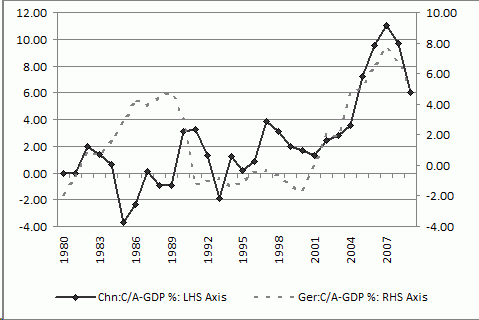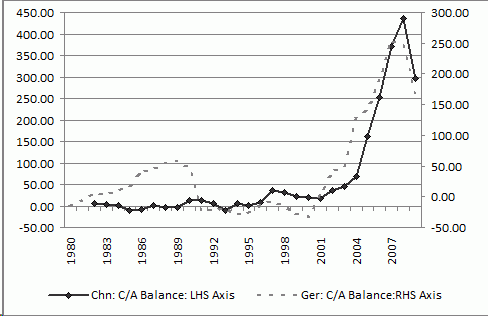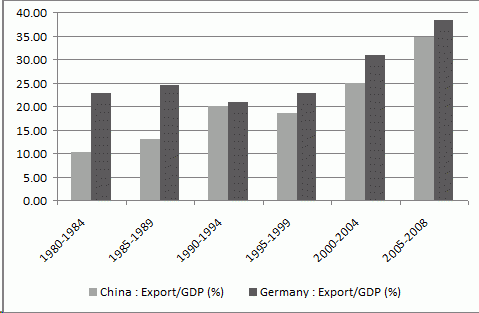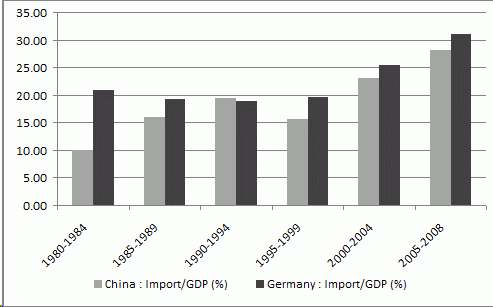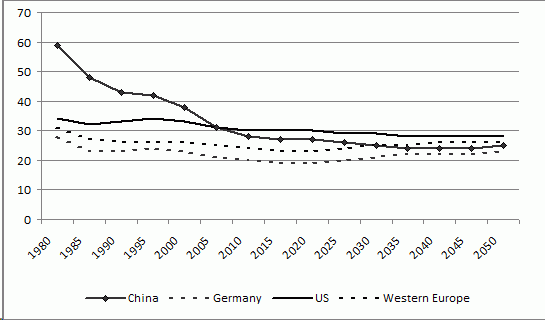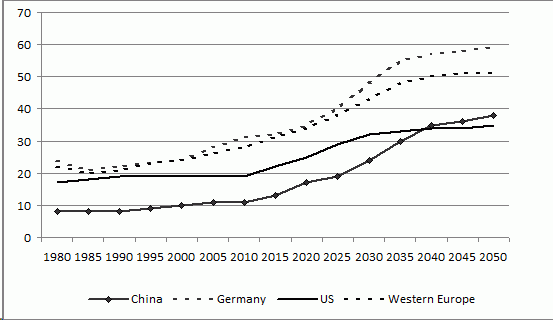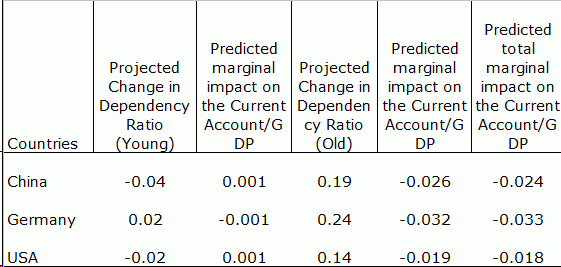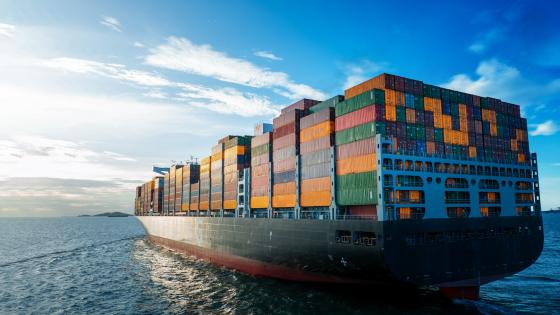Global imbalances are at the heart of rising political tensions in the international economic sphere (Claessens et al. 2010). For some observers, the sight of the advanced economies suffering from a dearth of aggregate demand while the world’s exporters enjoy large trade surpluses seems the result of beggar-thy-neighbour policies.1 China’s trade surplus is again growing steadily, most notably with the US, while the renminbi is still being held down by official policy. The US lower house has recently passed a protectionist bill aimed at forcing China to change its ways. And the Brazilian Finance Minister talks openly about competitive devaluations that he described as a “Currency war”.
Among the large surplus nations, China and Germany are standouts. Some observers have been led to align the two into a unified block sharing a similar agenda (and even the same name, Chermany, see Wolf 2010).
China as the new Germany?
In a recent paper (Aizneman and Sengupta 2010), we evaluate this conjecture in the context of global imbalances, and discuss what the future may hold for these surpluses.
Figure 1. Current account to GDP ratios of China and Germany
From a quick inspection of the data, China seems to be the new Germany rather than the other way round. Germany has been running significant current-account surpluses during most of the 1980s, reaching 5% of its GDP in the mid-1980s, at a time when China experienced current-account deficits (see Figure 1). Germany’s current-account moved towards a balanced position during the 1990s, possibly reflecting the fiscal challenges associated with unification with East Germany. Intriguingly, in the 2000s, the patterns of the current accounts of China and Germany became highly correlated, moving in tandem. Figure 2 suggests that an obvious common external factor was “accounting” for the current-account patterns of Chermany – the US current-account deficit.
Figure 2. Countries’ current account balance as a percentage of world GDP
The big economic story of the last 30 years has been the sustainable, high growth rate of Chinese economy. From a small economy close to autarky in 1980, China has now become a key player in the context of global imbalances. Until 1994, China’s contribution to global imbalances, measured in dollars, was practically nil. China’s current-account surplus accelerated from 2000s onwards, surpassing that of Gemany in 2007 (Figure 3). The trade openness of China, which was about one-third of Germany’s in the early 1980s, reached that of Germany in the 2000s (see Figures 4 and 5).2
Figure 3. Current account balance of China and Germany ($ billions)
Figure 4. Ratio of exports to GDP of China and Germany
Figure 5. Ratio of imports to GDP of China and Germany
But these facts hide one obvious difference between Germany and China. Germany has been the anchor of exchange rate of the core of Europe both before the euro (as leader of the so-called DM Bloc and ERM) and after the euro. During the last 30 years the average current account of the Euro block was close to a balanced position (see Figure 2). Thus, as long as the Eurozone is viable, and its current account is closed to balance, Germany’s current-account surplus is basically a European – not global – issue.
China, by contrast, is de-facto part of the dollar block – a block that seems to have been characterised during the 2000s by sizable current-account surpluses of China, moving in tandem (but in opposite direction) with the current account of the US. Indeed, most of the balancing of the current-account deficits of the US during the 2000s was done by East Asia and the oil and commodity exporting countries. Ironically, Germany seems to play the role of China within the Eurozone, de-facto financing deficits of other members.
Data analysis and future trends
To formally compare China and Germany, we evaluate the patterns of the current-account-to-GDP ratios of China and Germany between 1970 and 2009 as a function of lagged conditional variables, applying the seemingly unrelated regression model (see our paper for details). A result common to all our estimations is the key importance of the US current account.
- We find that a rise in US current-account deficit by 1% of GDP is associated with an equal percentage rise of the current-account surpluses of China and Germany.
- The growth rate of global GDP seems to be playing an important role for Germany, but not for China.
The dominance of the US as the spender or demander of last resort before the crisis, and the importance of the global growth rate in accounting for the surpluses of Germany, hints at the limited viability of large future current-account surpluses of China and Germany. This may especially be the case if the drop in US current-account deficit to GDP ratio continues beyond the crisis period.
Global imbalances as a two-way street
In the global equilibrium, the sum of all current accounts should add up (subject to statistical discrepancy) to zero. Hence, focusing on the creditors as the source of the challenges facing the global economy overlooks the contribution of the US itself to global imbalances. Similarly, focusing only on the debtor(s) would overlook the need for all parties to move from the pre-crisis state of affairs to the post-crisis one.
There are reasons to expect that the pre-crisis trends may be unsustainable. In 2000-2007, the US current-account deficit to GDP ratio was about 4-5%, funded partially by Chinese surpluses of about 8%-10%, and significant current-account surpluses of oil exporters, and few other countries. Looking forward however, demographic factors are likely to impose significant balancing effects on future current-account trends.
Figures 6 and 7 suggest that future demographic transitions will work towards narrowing the surpluses of China and Germany.
Figure 6. Projections of dependency ratios (young)
Figure 7. Projections of dependency ratios (old)
- During the next 30 years, the dependency ratio of the old (population share of 65 years and older) in Germany and China will increase dramatically relative to the US.
- The dependency ratio of the old in the German and Chinese population is projected to increase during 2010-2035 by about 24% and 19%, respectively, whereas that of the US is expected to increase by 14%.
- The dependency ratio of the young (population share of 15 years and younger) in Germany is projected to increase by 2%, whereas that of the US and China are predicted to fall by 4% and 2%, respectively.
These trends may work towards mitigating the surpluses of China and Germany.
Table 1 summarises the projected changes in the dependency rates, and their projected marginal contributions, applying the regression results of Gruber and Kamin (2007). The demographic transitions of China and Germany in the next 25 years are projected to reduce their current account to GDP ratio by about 2.5% and 3.5%, respectively. This effect is stronger for Germany, reflecting the greater increase in the old dependency ratio in Germany. These adjustments tend to be front-loaded, as the old dependency ratio curves in Figure 7 follow logistic patterns, and hence this process is likely to kick-in early on.
Table 1. Predicted impact of demographic changes on current account/GDP between 2010 and 2035
The demographic transition in the US is projected to increase the US current-account deficit to GDP ratio by 2%, suggesting that demographics would not mitigate the need of the US to increase its net savings. In contrast, the projected demographic transitions in China and Germany would reduce their current-account surpluses, mitigating their contribution to global imbalances.
Future growth and unwinding global imbalances
Most observers expect the growth rates of China and other emerging markets to exceed that of the US and the OECD countries by a large margin over the coming years. This trend has important repercussions on the future global imbalances, and the current accounts of China and Germany. A small country embarking on export-led growth, such as China in the 1970s, can do so without imposing negative ripple effects as long as its relative size remains small. But the long-run success of the Chinese growth strategy may put in motion forces that could curtail the sustainability of a high GDP growth rate and a large current-account surplus path. By now, China has reached a critical mass of “an elephant running in a China store.”
The continuation of the pre-crisis path of the Chinese GDP growth rate exceeding 10% a year while sustaining a current-account to GDP ratio of 10 % would require, overtime, large increases in the current-account to GDP ratios of large players, like the US who are expected to grow at a much slower rate. Short of the emergence of a new demander of last resort, we can therefore reasonably expect the unwinding of global imbalances in the coming years. Indeed, the US is already facing deleveraging “stabilisation blues”. The housing market weaknesses and the resultant private sector deleveraging point to a probable reduction of consumption and increase in saving, thereby curtailing US current-account deficits.
The unwinding of global imbalances may be facilitated by China making a gradual shift from export-led growth towards a more balanced growth of internal demand – a strategy that may be consistent with the continuation of Chinese employment and GDP growth. The continued rise in the share of emerging markets in global GDP may provide a further impetus for Asian countries to switch towards heavier reliance on policies boosting domestic demand. This in turn suggests the presence of market forces that may provide added impetus for China and other emerging markets to scale down their current-account surpluses over time.
References
Aizenman, J and R Sengupta (2010), “Global Imbalances: Is Germany the new China? A Skeptical View”, manuscript, UCSC.
Claessens, Stijn, Simon J Evenett, and Bernard Hoekman (2010), “Rebalancing the global economy: A primer for policymaking”, VoxEU.org Publication, 23 June.
Gruber JW and SB Kamin (2007), “Explaining the global pattern of current account imbalances”, Journal of International Money and Finance, 26(4):500-522.
Suominen, Kati (2010), “Did global imbalances cause the crisis?”, VoxEU.org, 14 June.
Wolf, M (2010), “China and Germany Unite to Impose Global Deflation”, Financial Times, 16 March.
1 See Kati Suominen (2010) on this site for a review of the debate on whether the global imbalances caused the crisis.
2 The correlation coefficients between the current accounts (in dollars) of China and Germany between 1980-1994 and 1995-2009 were, -0.29 and 0.93 respectively.
